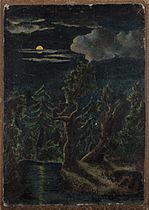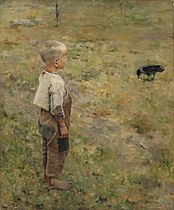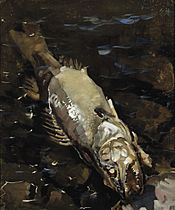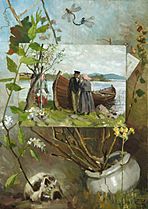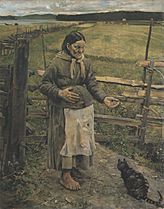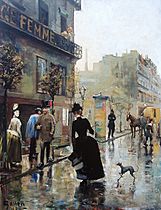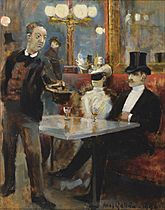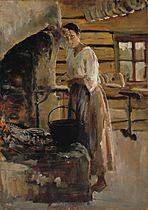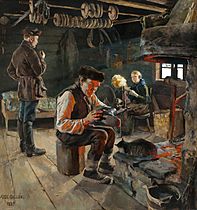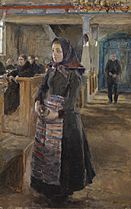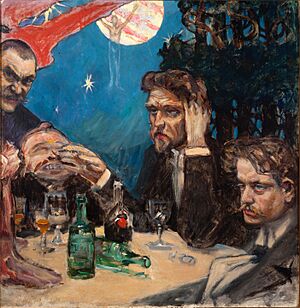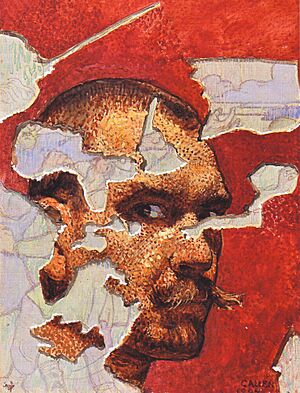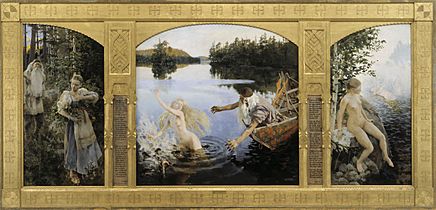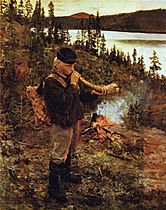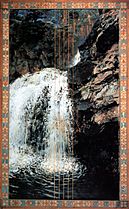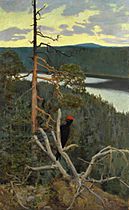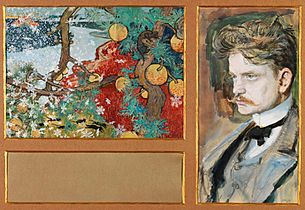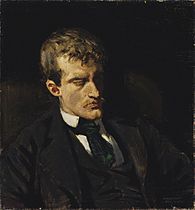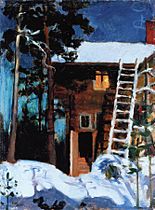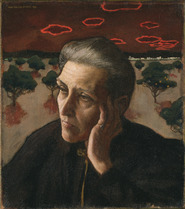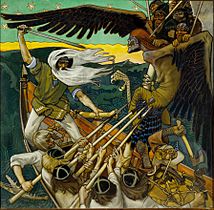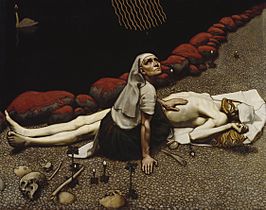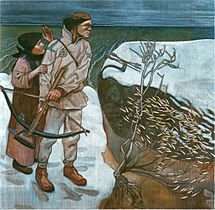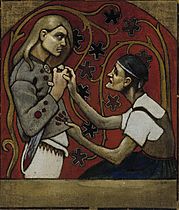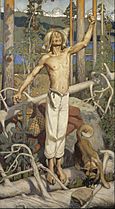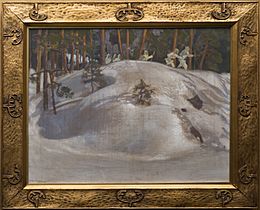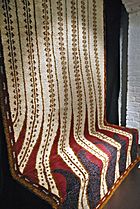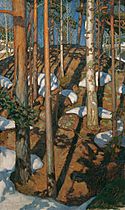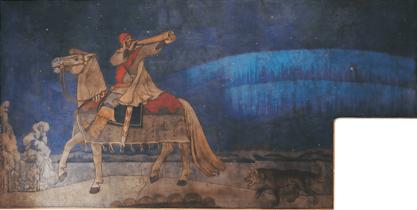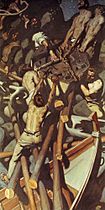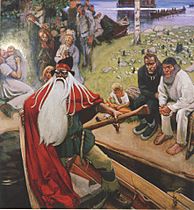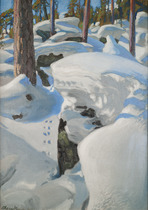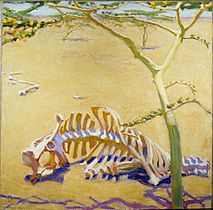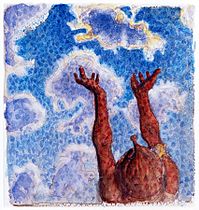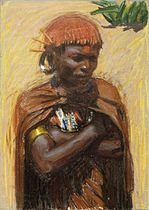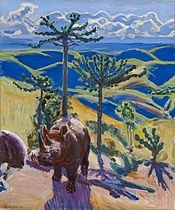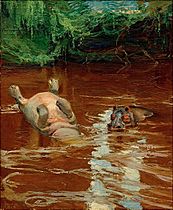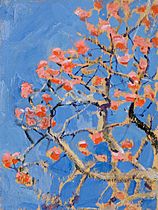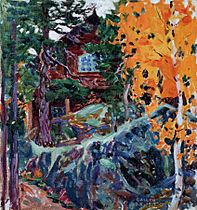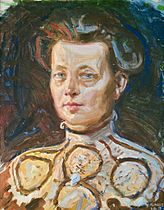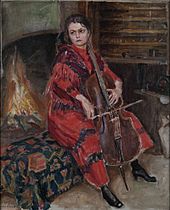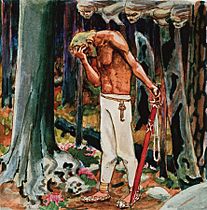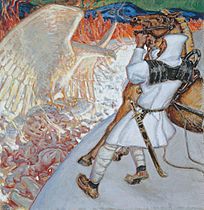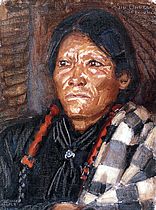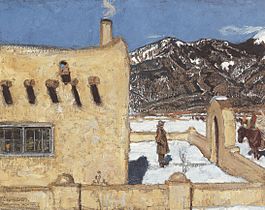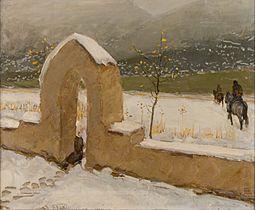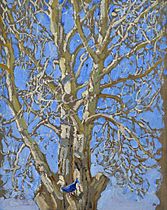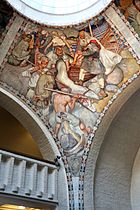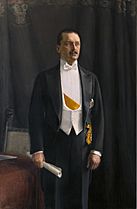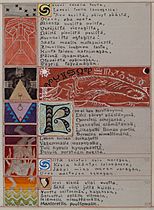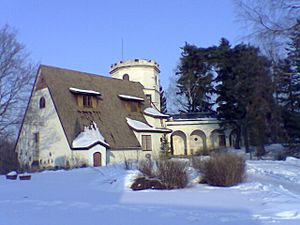Akseli Gallen-Kallela facts for kids
Quick facts for kids
Akseli Gallen-Kallela
|
|
|---|---|
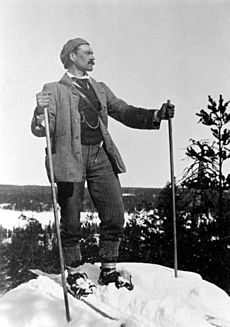 |
|
| Born |
Axel Waldemar Gallén
26 April 1865 |
| Died | 7 March 1931 (aged 65) |
| Nationality | Finnish |
| Known for | Painting |
| Movement | Romantic nationalism, Realism, Symbolism |
Akseli Gallen-Kallela (born April 26, 1865 – died March 7, 1931) was a famous Finnish painter. He is best known for his amazing pictures that tell stories from the Kalevala. The Kalevala is the national epic (a long poem or story) of Finland. His artwork is super important for understanding what it means to be Finnish. He even changed his name in 1907 from Gallén to Gallen-Kallela to sound more Finnish.
Contents
Life and Art Journey
Growing Up and Becoming an Artist
Akseli Gallen-Kallela was born Axel Waldemar Gallén in Pori, Finland. His family spoke Swedish. His dad, Peter Gallén, was a police chief and a lawyer. Akseli grew up in Tyrvää. When he was 11, his father sent him to Helsinki to study at a regular school. His dad didn't want him to be a painter.
But after his father passed away in 1879, Akseli started taking drawing classes. He studied at the Finnish Art Society from 1881 to 1884. He also had private lessons with a teacher named Adolf von Becker.
Studying in Paris
In 1884, Akseli moved to Paris, France. He went there to study art at the Académie Julian. In Paris, he made friends with other artists and writers. These included the Finnish painter Albert Edelfelt, the Norwegian painter Carl Dørnberger, and the Swedish writer August Strindberg. During these years, he often traveled between Finland and Paris.
Family Life and the Kalevala
Akseli married Mary Slöör in 1890. They had three children: Impi Marjatta, Kirsti, and Jorma. On their honeymoon, they traveled to East Karelia. This trip was important because Akseli started gathering ideas for his paintings about the Kalevala.
During this time, he painted many romantic pictures inspired by the Kalevala, like the Aino Myth. He also painted beautiful landscapes. By 1894, his art started to show more Symbolism. This art style uses symbols to represent ideas and feelings.
-
Akseli Gallen-Kallela - Madonna (Mary and Marjatta).png
Madonna (Mary and Marjatta), 1891
-
Akseli Gallen-Kallela - Conceptio Artis.jpg
Conceptio Artis, 1894
-
Sibelius as the Composer of En saga, 1894
-
Akseli gallen-kallela, ad astra, 1894.jpg
Ad Astra, 1894
A Difficult Time and Famous Works
In December 1894, Akseli went to Berlin to show his art with the Norwegian painter Edvard Munch. Around this time, Akseli also designed a large cabin called Kalela for his family. It was built far away from cities, by a lake. Thirteen local carpenters built it from pine trees in about a year.
In March 1895, Akseli's trip ended suddenly. He received sad news that his daughter, Impi Marjatta, had died from an illness. This event changed his art a lot. Before, his paintings were more romantic. After his daughter's death, his works became more intense and powerful.
From 1896 to 1899, he painted some of his most famous works. These include The Defense of the Sampo, Lemminkäinen's Mother, Joukahainen's Revenge, and Kullervo's Curse. In May 1895, Akseli and Mary visited London. He wanted to buy a printing press for graphic art. He also learned about stained glass there. Later, in 1897, the family traveled to Florence and Pompeii. He studied frescoes (paintings on wet plaster) there.
World's Fair and Important Murals
For the Paris World Fair in 1900, Akseli Gallen-Kallela painted large frescoes for the Finnish Pavilion. One of these frescoes was called Ilmarinen Plowing the Field of Vipers. It had a secret political message. One of the vipers wore a tiny crown, showing Akseli's hope for Finland to become independent from Russia.
The Paris Exposition made Akseli Gallen-Kallela known as the most important Finnish artist. In 1901, he was asked to paint another fresco, Kullervo Sets Off for War. This one was for a concert hall in Helsinki. Between 1901 and 1903, he painted frescoes for the Jusélius Mausoleum in Pori. These were a memorial for an 11-year-old girl. Sadly, these frescoes were later damaged and destroyed by fire. Akseli's son, Jorma, later repainted them using the original drawings.
In 1907, Akseli officially changed his name to Akseli Gallen-Kallela. This new name sounded more Finnish. He also started planning a huge 700-page book called Great Kalevala.
-
Gallen-Kallela - Tuonelan joella.JPG
By the River of Tuonela, study for the Jusélius Mausoleum frescos, 1903
-
Lake Keitele, 1905
-
The Departure of Väinämöinen, 1906
-
The Lair of the Lynx, 1906
-
Akseli Gallen-Kallela - Bil-Bol, Poster for an Automobile Retailer.jpg
Bil-Bol, Poster for an Automobile Retailer, 1907
Adventure in Kenya
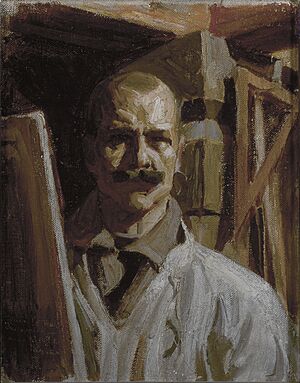
In 1908, Akseli and his family moved to Paris again. He wanted to find new inspiration for his art. But Paris and its new art styles didn't feel right to him. So, in May 1909, they moved much farther away to Nairobi in Kenya, Africa!
Akseli was the first Finnish artist to paint south of the Sahara desert. He created over 150 paintings there, using a style called expressionism. This style focuses on showing feelings and emotions. The colors in his Kenya paintings are especially amazing. The family returned to Finland in February 1911. After that, he designed and built a new studio and home called Tarvaspää. It was about 10 kilometers from Helsinki.
-
Gallen-Kallela, Aallottaret.jpg
The Oceanides, 1909
-
Kikuyu Woman, 1909
-
Gallen-Kallela, Homo victor.jpg
Homo Victor (Victorious Man), 1910
Finnish Civil War and National Symbols
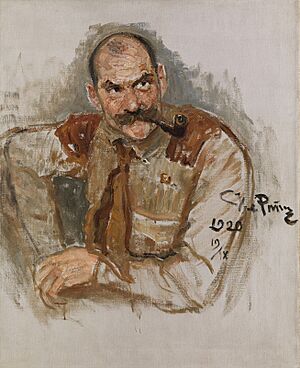
The family moved back to their Kalela cabin in 1915 to get away from the problems of World War I. A few years later, in 1918, Akseli and his son Jorma fought in the Finnish Civil War.
When the leader, General Mannerheim, heard about Akseli fighting, he asked him to design important symbols for the new independent Finland. Akseli designed flags, official awards, and uniforms. For the flag, he suggested a white cross on a blue background. But this was too similar to other flags, so it wasn't chosen. In 1919, he became an aide to General Mannerheim. In 1920, he made a deal to publish his big Great Kalevala book. A smaller version, Koru-Kalevala, came out first in 1922.
Travels to America and Final Years
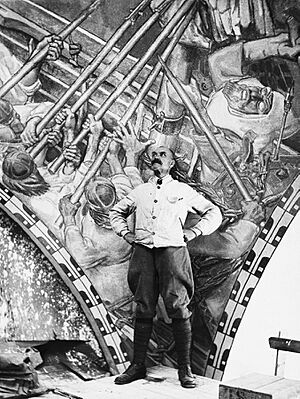
In December 1923, Akseli moved to the United States. His family joined him in the fall of 1924. He first spent time in Chicago, where his art was shown in several cities. In Chicago, he was very interested in Native American art. So, he moved to Taos, New Mexico, to an art colony there to learn more about it. During his time in the U.S., he also started planning his Great Kalevala book in much more detail.
In May 1926, the family returned to Finland. Two years later, in 1928, he and his son Jorma painted more Kalevala frescoes. These were in the lobby of the National Museum of Finland. In 1930, he agreed to paint a giant fresco for a bank. But on March 7, 1931, while returning from a lecture, he sadly died suddenly from pneumonia in Stockholm.
His Lasting Impact
Akseli Gallen-Kallela's studio and home at Tarvaspää was opened as the Gallen-Kallela Museum in 1961. You can see some of his artworks there. It's also a place where people can study more about his life and art.
See also
 In Spanish: Akseli Gallen-Kallela para niños
In Spanish: Akseli Gallen-Kallela para niños
- Golden Age of Finnish Art
- Finnish art


